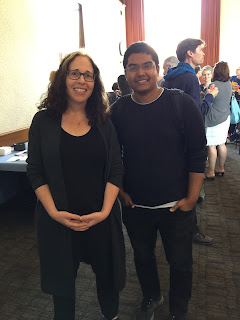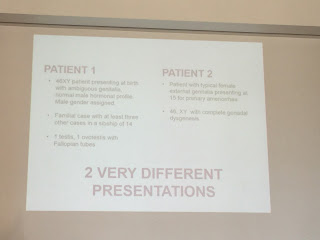EVENT 5: INTERSEX: BEYOND THE BINARY
This was a very different event compared to the others I
have attended this quarter. This event was not about art and neither was it
about the intersection of art and technology. However, it follows a similar
theme, which is the intersection of two contrasting fields. In this case the
discussion is focused on the intersex, and how both the social and medicinal
worlds play a role in their life. I found this to be a very important event
primarily because I found myself terribly under informed about intersex.
Although I attribute this partially to my own ignorance but there is also the
fact that knowledge regarding intersex is not that common, and there is a need
to address this issue.
 |
| Proof of attendance |
This event was organized by EPIDAPO, an organization that
focuses on the new field of epigenetics, which is the study of changes in
organisms due to modification in gene expression. The representative from
EPIDAPO, started the discussion by talking about the clinical terminology used
to refer to intersex individuals, which is DSD (Disorders of sex development). They
talked about how the word “disorder” has negative connotations, and cause of
pathologization of the condition. They followed this by raising the key issue
of medical normalization. This usually involves surgeries to assign a gender to
the individual along with hormonal treatment. Their speech ended with raising
some very probing questions: Should there be an attempt at medical
normalization? How to care for the intersex? What does caring even entail when
related to the intersex?
The first lecturer was Ellen Feder from American University,
Washington. She is a professor of Philosophy and Social Policy, and she
presented her take on the care of intersex in the current society. Her
presentation was very interesting because it was based around the concept of
curiosity in the medical field. She started by discussing the topic of Intersex
Management, which is the basic procedures and advice given by medical
professionals to manage with being intersex. The psychologist John Money wrote
the standard procedure for this management. Money made normalization of
intersex the standard procedure, as he strongly believed in the binary division
of sex: male and female. In order to confirm to these genders, it was important
to undergo medical procedure. Professionals in the medical industry are now
realizing that this is far from a solution and actually creates a lot more
problems. Patients tend to undergo extreme trauma, either from remember too
much of the excruciatingly painful process, or being stuck in a web of secrecy
where their owen condition is hid from them.
Money was the main figure in this speech, as he seemed to
have two sides. The one side being that he was very compassionate towards
people of this condition and always treated them without any judgment. However,
the other side was a problem. Out of his need to become a pioneer in his field,
he lost the initial curiosity that caused him to study intersex. He became
obsessed with the idea of two genders, and stifled any curiosity about gender
being more fluid than that. Feder’s speech used Money as an example to show the
need for medical curiosity, but also to show the cautionary tale of the result
of lack of curiosity. She pointed out that as of now, medical curiosity about
the proper care, long term effects and accompanying complications of intersex
seems to be low. She urged professionals in the industry to provide more
attention to this issue.
 The second lecturer was Dr. Eric Vilain, an esteemed
professor at UCLA. His talk was based around the implications of the name DSD,
as well as a discussion on traditional views on gender and intersex along with
the new challenging views on those topics. Although DSD on first glance gives
us the impression that it is an oppressive term, Dr. Vilain pointed out that
the term was a big stride in the right direction. Traditionally gender taxonomy
was based on gonodal tissue (its presence or absence). However DSD, which is
defined as a congenital condition in which the development of chromosomal,
gonadal or anatomical sex is atypical, is more comprehensive. There is an
active debate on whether the term DSD should stay or is intersex the more
appropriate name. However there are merits to both sides. DSD term has clinical
value but intersex is vague. Furthermore, intersex has a political meaning,
which DSD doesn’t.
The second lecturer was Dr. Eric Vilain, an esteemed
professor at UCLA. His talk was based around the implications of the name DSD,
as well as a discussion on traditional views on gender and intersex along with
the new challenging views on those topics. Although DSD on first glance gives
us the impression that it is an oppressive term, Dr. Vilain pointed out that
the term was a big stride in the right direction. Traditionally gender taxonomy
was based on gonodal tissue (its presence or absence). However DSD, which is
defined as a congenital condition in which the development of chromosomal,
gonadal or anatomical sex is atypical, is more comprehensive. There is an
active debate on whether the term DSD should stay or is intersex the more
appropriate name. However there are merits to both sides. DSD term has clinical
value but intersex is vague. Furthermore, intersex has a political meaning,
which DSD doesn’t.
At the same time, Dr. Vilain pointed out, clinical terms
seem to have an actual social impact which cannot be disregarded. Originally
the word “disorders” was put in to bring doctors to the table and not be rash
with their diagnosis. But at this point, now that the medical community is
better informed, the word disorders needs to be removed to stop the negative
connotations. He also expressed the need to stop forcing intersex individuals
to confirm to the binary genders, and cultivate an open society where this
identity does not need to be hidden.
I think it is important for the general public to be aware
of this discussion and to be actively a part of this development. This was a
very rewarding event and I highly recommend others to attend it.





Comments
Post a Comment